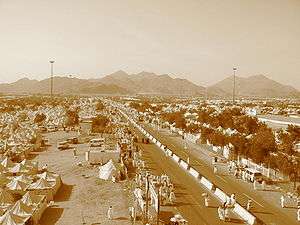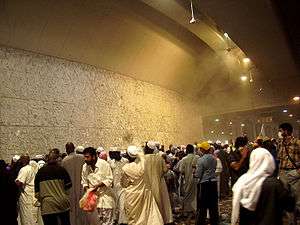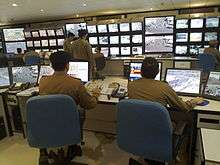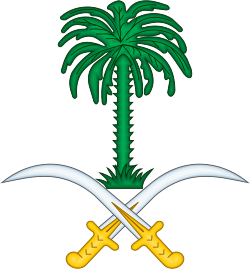Incidents during the Hajj
There have been numerous incidents during the Hajj', the Muslim pilgrimage to the city of Mecca, that have caused loss of life. Every follower of Islam is required to visit Mecca during the Hajj at least once in his or her lifetime, if able to do so; according to Islam, the pilgrimage is one of the Five Pillars of Islam. During the month of the Hajj, Mecca must cope with as many as three million pilgrims.[1]

Plane travel makes Mecca and the Hajj more accessible to pilgrims from all over the world. As a consequence, the Hajj has become increasingly crowded. City officials are required to control large crowds and provide food, shelter, sanitation, and emergency services for millions. However, it has not always been possible to prevent incidents.
Crushes and failures of crowd control
| Wikinews has related news: |

Sometimes the dense, surging troupes, trekking from one station of the pilgrimage to the next, cause a stampede, or more precisely, a progressive troupe collapse. At densities above 6 or 7 persons per square meter, individuals cannot move, groups are swept along in waves, individuals jostle to find breath and to avoid falling and being trampled, and hundreds of deaths can occur as a result. The stoning of the devil (ramī aj-jamarāt) ceremony is particularly crowded and dangerous. Pilgrims ritualistically throw pebbles at three walls (formerly pillars) which represent the three places where the Hadiths describes how the devil tempted Abraham. It is one of a series of ritual acts that must be performed during the Hajj.
Some notable incidents include:
- July 2, 1990: A stampede inside a pedestrian tunnel (Al-Ma'aisim tunnel) leading out from Mecca towards Mina and the Plains of Arafat led to the deaths of 1,426 pilgrims, many of them of Malaysian, Indonesian and Pakistani origin.[2][3]
- May 23, 1994: A stampede killed at least 270 pilgrims at the stoning of the Devil ritual.
- April 9, 1998: at least 118 pilgrims were trampled to death and 180 injured in an incident on Jamaraat Bridge.[4]
- March 5, 2001: 35 pilgrims were trampled to death in a stampede during the stoning of the Devil ritual.[5]
- February 11, 2003: The stoning of the Devil ritual claimed 14 pilgrims' lives.[6]
- February 1, 2004: 251 pilgrims were killed and another 244 injured in a stampede during the stoning ritual in Mina.[7]
- January 22, 2005: A stampede through the stoning ritual in Mina led to the killing of three pilgrims[8]
- January 12, 2006: A stampede during the stoning of the Devil on the last day of the Hajj in Mina killed at least 346 pilgrims and injured at least 289 more. The incident occurred shortly after 13:00 local time, when a busload of travelers arrived together at the eastern access ramps to the Jamaraat Bridge. This caused pilgrims to trip, rapidly resulting in a lethal stampede. An estimated two million people were performing the ritual at the time.
- September 24, 2015: At least 2,236[9] pilgrims were killed during a stampede. The Saudi government has yet to release an official report. A few weeks after the incident, the Saudi Vice Minister of Health officially announced 4,173 people dead in this incident in a press release,[10][11] however, this page was removed from the website within three hours and requesting it would redirect the visitor to the home page. The Saudi Health Minister claimed that the published death toll was false in a Twitter post.[12] Fars News, a semi-official news agency of Iran, provided a walkthrough video to accessing the page assuming it was out of reach due to high page requests.[13] An Associated Press (AP) report compiled from official reports and statements totaled the deaths at at least 1,470, over 700 more than the figures from Saudi authorities, and the worst toll so far in Mecca.[14] The AP later updated its estimate to 2,411 pilgrims killed.[15]
Fires
- December 1975: An exploding gas cylinder caused a fire in a tent colony and resulted in the deaths of 200 pilgrims.[16]
- April 15, 1997: 343 pilgrims were killed and 1,500 injured in a tent fire.[17] The tents are now fireproof.
- February 13, 2002: Forty Hajj pilgrims from the UAE died when the bus they were traveling in collided head-on with a truck in Saudi Arabia's Al Ihsa province.
- November 1, 2011: Two pilgrims, a wife, and husband, died in a coach fire. There were two coaches in the convoy, and a person in the second coach noticed smoke billowing from the coach in front. He radioed the driver to stop. Everybody evacuated the coach, and as the last two were getting out, the coach suffered three explosions.
Protests and violence
- 692: The siege of Mecca occurred when Umayyad general Hajjaj ibn Yusuf besieged Mecca on 25 March 692. The city was bombarded using catapults and continued during the Hajj rituals. It resulted in the Kaaba being damaged. It was then rebuilt again.[18]
- 930: On the first day of Hajj, Qarmatian leader Abu Tahir al-Jannabi led an attack on Mecca and set about massacring the pilgrims. While killing pilgrims, he taunted them with verses of the Koran as they did so[19], and verses of poetry: "I am by God, and by God I am ... he creates creation, and I destroy them". About 30,000 pilgrims were killed. The bodies of the pilgrims were left to rot in the streets or were thrown down the Well of Zamzam. The Kaaba was looted, houses were plundered, and slaves seized. He removed the Black Stone and it was in his possession for 21 years.
- 1502: The Mira, a ship carrying Hajj-pilgrims returning from Mecca was set ablaze on the orders of Portuguese explorer Vasco da Gama. Around 300 pilgrims were killed.[20]
- 1695: On 7 September, pirates led by Henry Every hijacked Grand Mughal vessels which were making the annual pilgrimage to Mecca. The pirates then subjected their captives to several days of horror, raping and murdering prisoners at will, and using torture to force them to reveal treasure.[21] Some of the women committed suicide by jumping into the sea.[22]
- 1757: The 1757 Hajj caravan raid was the plunder and massacre of the Hajj caravan of 1757 on its return to Damascus from Mecca by Bedouin tribesmen. An estimated 20,000 pilgrims were killed as a result of the raid.
- 1979: The 1979 Grand Mosque seizure was organized by extremist Juhayman al-Otaybi and his supporters. They seized the mosque and overpowered Saudi security and police. Later more Saudi military unites plus elite units from Pakistan and France were sent to stop the rebellion. Juhaiman and some of the organisers were later executed[23]
- July 31, 1987: A clash between Iranian demonstrators and Saudi security forces led to the deaths of more than 400 pilgrims and thousands injured.
- July 9, 1989: Two bombs exploded, killing one pilgrim and wounding another 16.[24]
Airplane crashes related to the Hajj
- January 22, 1973: A Royal Jordanian Boeing 707 crashed at Kano, Nigeria, killing 176 Hajj pilgrims returning from Mecca.
- December 4, 1974: Martinair Flight 138 crashed near Colombo, Sri Lanka, killing all 191 people aboard – 182 Indonesian hajj pilgrims bound for Mecca, and 9 crew members.
- November 15, 1978: Icelandic Airlines Loftleiðir HF Flight LL 001 crashed at Colombo, Sri Lanka, killing 170 (mostly Indonesian) Muslim pilgrims returning from the Hajj.
- November 26, 1979: Pakistan International Airlines Flight 740 had an in-flight fire and crashed after takeoff from the old Jeddah International Airport on 26 November 1979 killing all 156 on board the Boeing 707.
- August 19, 1980: Saudia Flight 163 had a cargo compartment fire shortly after take-off from Riyadh airport. All 287 passengers and 14 crew on board the Lockheed L-1011-200 TriStar, registration HZ-AHK, died after the aircraft made an emergency landing.
- July 11, 1991: Nigeria Airways Flight 2120 (operated by Nationair) was a chartered passenger flight from Jeddah, Saudi Arabia, to Sokoto, Nigeria which had an in-flight fire and crashed shortly after takeoff from King Abdulaziz International Airport, killing all 247 Hajj pilgrims and 14 crew members on board the DC-8.
Disease
Mingling of visitors from many countries, some of which have poor health care systems still plagued by preventable infectious diseases, can lead to the spread of epidemics. If an outbreak were to occur on the road to Mecca, pilgrims could exacerbate the problem when they returned home and passed their infection on to others. This was more of a problem in the past. One such disease, which has prompted response from the Saudi government, is meningitis as it became a primary concern after an international outbreak following the Hajj in 1987. Due to post-Hajj outbreaks globally of certain types of meningitis in previous years, it is now a visa requirement to be immunised with the ACW135Y vaccine before arrival. Every year, the Saudi government publishes a list of required vaccines for pilgrims, which for 2010 also included yellow fever, polio, and influenza.[25][26]
Middle East respiratory syndrome
As of 9 September 2013, the Saudi government asked "elderly and chronically ill Muslims to avoid the hajj this year" and restricted the numbers of people allowed into the country due to Middle East respiratory syndrome coronavirus (MERS-CoV).[27][28] Although MERS-CoV was not detected among pilgrims, this does not rule out risk of the disease at Hajj.[29] The disease, though, is only mildly contagious.
COVID-19
The spread of the 2019 coronavirus prompted the Saudi Arabian government to discourage people from planning for the Hajj in 2020. On April 21, the Saudis announced that there would be no public attendance at Taraweeh in Mecca or in Medina.[30]
Historical outbreaks
During the 1821 Hajj, about 20,000 Meccan pilgrims died due to a cholera epidemic. The disease had started in India in 1817.[31]
Another cholera epidemic began in 1863. It started in the Ganges Delta of the Bengal region and traveled with Muslim pilgrims to Mecca during the 1865 hajj. In its first year, the epidemic claimed the life of 15,000 to 90,000 pilgrims. Cholera spread throughout the Middle East and was carried to Russia, Europe, Africa and North America. It resulted in the death of almost 600,000 people.[32][31]
In 1905 the El Tor strain of cholera was discovered in six pilgrims returning from Hajj at the El-Tor quarantine camp in Egypt.
In 2009, 73 cases of H1N1, which is also known as swine flu were recorded at the final days of Hajj. 5 pilgrims died due to the virus.[33]
Construction failures
2006 Al Ghaza hotel collapse
A concrete multi-story building located in Mecca close to the Grand Mosque collapsed on January 5, 2006. The building, the Al-Ghaza Hotel, is said to have housed a restaurant, a convenience store, and a hotel. The hotel was reported to have been housing pilgrims to the 2006 Hajj. It is not clear how many pilgrims were in the hotel at the time of the collapse. As of the latest reports, the death toll was 76 and the number of injured was 64.[34]
2015 crane collapse
A crane fell in the grand mosque on September 11, 2015, ten days before Hajj, causing 118 deaths and 394 injuries.
Other fatal events
Of the millions of pilgrims each year, many are elderly, and some die of their illnesses, exacerbated in some cases by the heat and exertion.
- On November 25, 1908, the passenger-cargo ship SS Sardinia caught fire off Malta's Grand Harbour and ran aground, resulting in at least 118 deaths. Most of the casualties were Moroccan pilgrims on their way to Mecca.[35][36]
- Before the beginning of the first day of the December 2006 Hajj, 243 pilgrims had died, according to a statement by the Saudi government.[37] The majority of deaths were reportedly related to heart problems, exhaustion in the elderly and people with weak health, caused by the heat and tiring physical work involved in the pilgrimage. After the conclusion of the Hajj, the Nigerian government reported that 33 nationals had died mostly "as a result of hypertension, diabetes and heart attack", not due to epidemic illnesses, and rejected assertions that Nigerian pilgrims died in an accident on a road to Mina.[38] Egypt's official news agency has reported that by December 30 (10 Dhu al-Hijjah), 22 Egyptian pilgrims had died.[39] Four elderly Filipino pilgrims in their 50s died during the pilgrimage of illnesses or other 'natural causes', and were buried in Mecca.[40] The Pakistani Hajj Medical Commission has announced that approximately 130 Pakistani pilgrims died during the Hajj season in Saudi Arabia, "mostly aged and victims of pneumonia and heart patients", and that 66 pilgrims were admitted to Saudi hospitals for similar ailments.
- In early December 2006, a coach carrying pilgrims from holy sites in Medina to Mecca crashed 55 miles north of the port of Rabegh near Jeddah, killing 3 Britons and injuring 34 others, including two children.[41]
- In 2009, 77 pilgrims performing Hajj were killed due to floods.[42]
- In November 2011, thirteen Afghans died and a dozen others were wounded as a result of illness and traffic accidents.[43]
Pickpocketing
Of late, pickpocketing has created numerous problems for Hajj pilgrims. According to the Save Madina Foundation, 321 were victims of pickpocketing during Hajj in 2010.[44]
Sexual abuse and miscarriages
Female pilgrims have spoken up about sexual abuse experienced on the Hajj through a movement called the Mosque Me Too movement.[45][46] Using the hashtag #MosqueMeToo, which stems from the Me Too movement which used the hashtag #MeToo, Muslim women have shared their experiences online about sexual abuse in Mecca.[47][48][49]
Many pregnant pilgrims get miscarriages due to performing the hajj. In 2011, 20 pregnant women performing the pilgrimage had miscarriages due to exhaustion. In 2018, an unspecified number of pregnant Nigerian pilgrims suffered miscarriages.[50]
Official responses

Critics say that the Saudi government should have done more to prevent such tragedies. The Saudi government insists that any such mass gatherings are inherently dangerous and difficult to handle, and that they have taken a number of steps to prevent the problems. The fatalities in the largest tragedy in September 2015 are alleged to have been downplayed by the Saudis by as many as 1,700.[15]
One of the biggest steps, which is also controversial, is a new system of registrations, passports, and travel visas to control the flow of pilgrims. This system is designed to encourage and accommodate first-time visitors to Mecca, while restricting repeat visits. Pilgrims who have the means and desire to perform the Hajj several times have protested what they see as discrimination, but the Hajj Commission has stated that they see no alternative if further tragedies are to be prevented.
Following the 2004 stampede, Saudi authorities embarked on major construction work in and around the Jamaraat Bridge area. Additional accessways, footbridges, and emergency exits were built, and the three cylindrical pillars were replaced with concrete walls to enable more pilgrims simultaneous access to them without the jostling and fighting for position of recent years. The government has also announced a multimillion-dollar project to expand the bridge to five levels; the project is planned for completion in time for the 1427 AH (Dec. 2006 – Jan. 2007) Hajj.[51] Following the 2006 incident, the Jamaraat Bridge and the pillars representing Satan were demolished and reconstructed. A wider, multi-level bridge was built, and massive columns replaced the pillars themselves. Now, each level of the bridge allows easier and safer access to the columns representing Satan. In addition, the stoning ceremony must be carried out according to pre-determined schedules to prevent over-crowding and the attendant risks. The Jamaraat basin has been expanded from its current circular shape into an oval to allow better access to the pillars. The new arrangements provide for separate access and departure routes.[52] However, a security breakdown is mentioned as cause for the 2015 stampede. A group of pilgrims who had cast their own stones and were returning to their camp, instead of taking the route designated for returning pilgrims, they took the route meant for those who were coming and crossed the other group of pilgrims heading straight to the jamaraat.[54][55]
References
- "Pilgrims mark end of peaceful hajj: Circling of Kaaba brings to close perhaps largest-ever pilgrimage to Mecca]". BBC News. January 2, 2007. Archived from the original on September 5, 2017. Retrieved November 18, 2019.
This year’s hajj was likely the biggest ever, with authorities estimating that around 3 million people participated.
- "True Islam". Quran-Islam.org. Archived from the original on 2013-03-13. Retrieved 2013-07-31.
- "A history of hajj tragedies | World news". London: theguardian.com. January 13, 2006. Archived from the original on August 29, 2013. Retrieved 2013-07-31.
- "Saudis identifying nationalities of 118 dead pilgrims". BBC News. April 9, 1998. Archived from the original on September 2, 2017. Retrieved January 12, 2006.
- "BBC News – MIDDLE EAST – Lessons from Hajj deaths". News.bbc.co.uk. Archived from the original on 20 October 2014. Retrieved 11 October 2014.
- "Fourteen killed in Hajj stampede". BBC News. February 11, 2003. Archived from the original on January 12, 2006. Retrieved January 13, 2006.
- "BBC NEWS – Hundreds killed in Hajj stampede". News.bbc.co.uk. Archived from the original on 20 October 2014. Retrieved 11 October 2014.
- Staff, Writer. "Timeline of tragedies during hajj pilgrimage in Mecca". theguardian. Archived from the original on 10 October 2015. Retrieved 24 September 2015.
- "Iran says tests will show cause of diplomat's death in Saudi". AFP. 27 November 2015. Archived from the original on 29 November 2015. Retrieved 29 November 2015.
- "نائب وزير الصحة: ارتفاع عدد وفيات التدافع في منی إلی 4173 شخصا". Archived from the original on 29 September 2015. Retrieved 4 October 2015.
- "الصحة السعودية: ارتفاع وفيات التدافع في منى إلى 4173+وثيقة". Archived from the original on October 10, 2015. Retrieved 20 October 2015.
- "تدافع_مشعر_منى" (12 October 2015). Twitter. Twitter. 12 October 2015. Archived from the original on 1 November 2015. Retrieved 12 October 2015.
- "Mina Tragedy Death Toll Exceeds 4,000". Archived from the original on 2 October 2015. Retrieved 29 September 2015.
- "Saudi crush was deadliest hajj tragedy ever". Associated Press. 10 October 2015. Archived from the original on 10 October 2015. Retrieved 10 October 2015.
- "AP count: Over 2,400 killed in Saudi hajj stampede, crush". The Associated Press. 10 November 2015. Archived from the original on 13 December 2015. Retrieved 1 January 2016.
- "Dokumentation: Die schwersten Unglücke bei der Hadsch – SPIEGEL ONLINE". SPIEGEL ONLINE. 12 January 2006. Archived from the original on 10 June 2012. Retrieved 11 October 2014.
- "Saudi diplomat: Hajj fire was an accident". CNN. 1997-04-16. Archived from the original on 2014-04-19. Retrieved 2014-04-18.
- Fishbein 1990, p. 225.
- Halm 1996, pp. 255 f..
- http://www.bbc.co.uk/history/british/tudors/vasco_da_gama_01.shtml&ved=2ahUKEwimmNSvyujnAhWPxzgGHcLqAHkQFjAKegQIBxAB&usg=AOvVaw1dHy8zTlhATaNTKHUie7Qo. Missing or empty
|title=(help) - Rennie, Neil (2013). Treasure Neverland: Real and Imaginary Pirates. Oxford: OUP Oxford. ISBN 9780191668654. Retrieved 27 June 2017.
- Doug Lennox (2008). Now You Know Pirates: The Little Book of Answers (illustrated ed.). Dundurn. p. 70. ISBN 978-1-55002-806-5.
- "Archived copy". Archived from the original on 2019-07-09. Retrieved 2019-07-09.CS1 maint: archived copy as title (link)
- Times, Youssef M. Ibrahim, Special To The New York (1989-09-22). "Saudi Arabia Beheads 16 Kuwaitis Linked to Pro-Iranian Terrorism". The New York Times. ISSN 0362-4331. Archived from the original on 2016-08-10. Retrieved 2016-10-02.
- "WHO – 22 October 2010, vol. 85, 43 (pp 425–436)". Who.int. Archived from the original on 13 November 2013. Retrieved 11 October 2014.
- Barasheed, Osamah; Rashid, Harunor; Heron, Leon; Ridda, Iman; Haworth, Elizabeth; Nguyen-Van-Tam, Jonathan; Dwyer, Dominic E.; Booy, Robert (November 2014). "Influenza Vaccination Among Australian Hajj Pilgrims: Uptake, Attitudes, and Barriers". Journal of Travel Medicine. 21 (6): 384–390. doi:10.1111/jtm.12146. PMID 25145836.
- "MERS virus claims three more lives in Saudi Arabia". AFP. September 7, 2013. Archived from the original on 11 September 2013. Retrieved 8 September 2013.
- Branswell, Helen (7 November 2013). "Spain reports its first MERS case; woman travelled to Saudi Arabia for Hajj". Vancouver Sun. Archived from the original on 9 November 2013. Retrieved 12 November 2013.
- Barasheed, Osamah; Rashid, Harunor; Alfelali, Mohammad; Tashani, Mohamed; Azeem, Mohammad; Bokhary, Hamid; Kalantan, Nadeen; Samkari, Jamil; Heron, Leon; Kok, Jen; Taylor, Janette; El Bashir, Haitham; Memish, Ziad A.; Haworth, Elizabeth; Holmes, Edward C.; Dwyer, Dominic E.; Asghar, Atif; Booy, Robert (14 November 2014). "Viral respiratory infections among Hajj pilgrims in 2013". Virologica Sinica. 29 (6): 364–371. doi:10.1007/s12250-014-3507-x. PMC 7090649. PMID 25413828.
- Usaid Siddiqui (23 April 2020). "Epidemics, war have impacted Muslim worship throughout history". Al Jazeera.
- Zumla, Alimuddin; McCloskey, Brian; Endericks, Tina; Azhar, Esam I.; Petersen, Eskild (2017-09-01). "The challenges of cholera at the 2017 Hajj pilgrimage". The Lancet Infectious Diseases. 17 (9): 895–897. doi:10.1016/S1473-3099(17)30454-1. ISSN 1473-3099. PMC 7129522. PMID 28803813.
- http://www.cbc.ca/news/technology/cholera-s-seven-pandemics-1.758504. Missing or empty
|title=(help) - Reuters, Caren Firouz / (2009-11-29). "Saudi official: 5 dead from swine flu at hajj". msnbc.com. Retrieved 2020-03-13.
- "Mecca Death Toll Rises to 76 – Forbes.com, 6 January 2006". Archived from the original on January 10, 2006. Retrieved 11 October 2014.
- "Gulf of Corcovado". Tyne Built Ships. Archived from the original on 8 July 2019. Retrieved 18 January 2020.
- "The Tragic end of the 'Maltese Titanic'". The Malta Independent. 7 October 2012. Archived from the original on 18 January 2020. Retrieved 18 January 2020.
- "Millions descend on Mecca for haj". Iol.co.za. Retrieved 11 October 2014.
- "Nigeria: Hypertension, Diabetes Kill 33 Nigerian Pilgrims in Saudi Arabia". Allafrica.com. Archived from the original on 30 September 2012. Retrieved 11 October 2014.
- "People's Daily Online–22 Egyptian pilgrims dies during Mecca hajj". English.people.com.cn. Archived from the original on 8 October 2012. Retrieved 11 October 2014.
- "Inquirer.net". Newsinfo.inq. Archived from the original on 15 December 2008. Retrieved 11 October 2014.
- "Third Briton died in Jeddah crash". BBC News. December 10, 2006. Archived from the original on January 10, 2007. Retrieved December 30, 2006.
- "77 Muslims killed while performing Hajj by Saudi floods | TopNews". topnews.us. Retrieved 2020-03-13.
- "13 Afghan pilgrims die during hajj". Pajhwok.com. Archived from the original on 19 October 2014. Retrieved 11 October 2014.
- Archived March 21, 2012, at the Wayback Machine
- "Muslim Women Are Speaking Out About Abuse". Time. Archived from the original on 2018-09-29. Retrieved 2018-03-10.
- Amidi, Faranak (2018-02-09). "Muslim women rally round #MosqueMeToo". BBC News. Archived from the original on 2018-03-10. Retrieved 2018-03-10.
- Eltahawy, Mona (2018-02-15). "Opinion | #MosqueMeToo: What happened when I was sexually assaulted during the hajj". Washington Post. ISSN 0190-8286. Archived from the original on 2019-05-22. Retrieved 2018-03-10.
- "Controversy over #MosqueMeToo sheds light on sexualized violence and xenophobia - Women's Media Center". Archived from the original on 2018-08-17. Retrieved 2018-03-10.
- "#MosqueMeToo: Women share experiences of sexual harassment inside religious places - Times of India". The Times of India. Archived from the original on 2018-07-31. Retrieved 2018-03-10.
- guardian.ng https://guardian.ng/news/pregnant-pilgrims-suffer-miscarriages-as-nigeria-records-more-death-in-saudi/. Retrieved 2020-03-13. Missing or empty
|title=(help) - "Hajj ritual sees new safety moves". BBC News. January 10, 2006. Archived from the original on January 12, 2006. Retrieved January 12, 2006.
- Archived January 4, 2014, at the Wayback Machine
- Yan, Holly. "What caused the deadly stampede at the Hajj?". CNN. Archived from the original on 9 September 2016. Retrieved 19 October 2016.
- "Archived copy". Archived from the original on 2015-10-01. Retrieved 2015-09-28.CS1 maint: archived copy as title (link)
External links
- Hundreds killed in Hajj stampede"
- "Hajj stampede kills hundreds"
- Jamarat Bridge Accidents
- Saudis review Hajj danger points
- Saudi-U.S. Relations Information Service – 10 January 2004
- Lessons from Hajj deaths at BBC News – 6 March 2001
- Pick Pocketing During Hajj
- The official Saudi Arabian Ministry of Hajj website
- Saudi's Handling of Hajj
